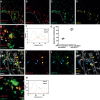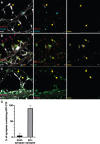A Super-Resolved View of the Alzheimer's Disease-Related Amyloidogenic Pathway in Hippocampal Neurons
- PMID: 34366358
- PMCID: PMC8543249
- DOI: 10.3233/JAD-215008
A Super-Resolved View of the Alzheimer's Disease-Related Amyloidogenic Pathway in Hippocampal Neurons
Abstract
Background: Processing of the amyloid-β protein precursor (AβPP) is neurophysiologically important due to the resulting fragments that regulate synapse biology, as well as potentially harmful due to generation of the 42 amino acid long amyloid β-peptide (Aβ42), which is a key player in Alzheimer's disease.
Objective: Our aim was to clarify the subcellular locations of the fragments involved in the amyloidogenic pathway in primary neurons with a focus on Aβ42 and its immediate substrate AβPP C-terminal fragment (APP-CTF). To overcome the difficulties of resolving these compartments due to their small size, we used super-resolution microscopy.
Methods: Mouse primary hippocampal neurons were immunolabelled and imaged by stimulated emission depletion (STED) microscopy, including three-dimensional three-channel imaging, and quantitative image analyses.
Results: The first (β-secretase) and second (γ-secretase) cleavages of AβPP were localized to functionally and distally distinct compartments. The β-secretase cleavage was observed in early endosomes in soma, where we were able to show that the liberated N- and C-terminal fragments were sorted into distinct vesicles budding from the early endosomes. Lack of colocalization of Aβ42 and APP-CTF in soma suggested that γ-secretase cleavage occurs in neurites. Indeed, APP-CTF was, in line with Aβ42 in our previous study, enriched in the presynapse but absent from the postsynapse. In contrast, full-length AβPP was not detected in either the pre- or the postsynaptic side of the synapse. Furthermore, we observed that endogenously produced and endocytosed Aβ42 were localized in different compartments.
Conclusion: These findings provide critical super-resolved insight into amyloidogenic AβPP processing in primary neurons.
Keywords: Alzheimer’s disease; Aβ42; amyloid-β protein precursor; stimulated emission depletion microscopy; synapse.
Conflict of interest statement
Authors’ disclosures available online (
Figures








Similar articles
-
The Alzheimer's Disease γ-Secretase Generates Higher 42:40 Ratios for β-Amyloid Than for p3 Peptides.Cell Rep. 2017 Jun 6;19(10):1967-1976. doi: 10.1016/j.celrep.2017.05.034. Cell Rep. 2017. PMID: 28591569
-
A novel gamma -secretase assay based on detection of the putative C-terminal fragment-gamma of amyloid beta protein precursor.J Biol Chem. 2001 Jan 5;276(1):481-7. doi: 10.1074/jbc.M005968200. J Biol Chem. 2001. PMID: 11035007
-
Different Expression Patterns of Amyloid-β Protein Precursor Secretases in Human and Mouse Hippocampal Neurons: A Potential Contribution to Species Differences in Neuronal Susceptibility to Amyloid-β Pathogenesis.J Alzheimers Dis. 2016;51(1):179-95. doi: 10.3233/JAD-150634. J Alzheimers Dis. 2016. PMID: 26836155
-
Localization and Trafficking of Amyloid-β Protein Precursor and Secretases: Impact on Alzheimer's Disease.J Alzheimers Dis. 2015;45(2):329-47. doi: 10.3233/JAD-142730. J Alzheimers Dis. 2015. PMID: 25589722 Review.
-
The Intersection of NGF/TrkA Signaling and Amyloid Precursor Protein Processing in Alzheimer's Disease Neuropathology.Int J Mol Sci. 2017 Jun 20;18(6):1319. doi: 10.3390/ijms18061319. Int J Mol Sci. 2017. PMID: 28632177 Free PMC article. Review.
Cited by
-
Lack of N-glycosylation increases amyloidogenic processing of the amyloid precursor protein.Glycobiology. 2022 May 23;32(6):506-517. doi: 10.1093/glycob/cwac009. Glycobiology. 2022. PMID: 35275192 Free PMC article.
-
The interwoven fibril-like structure of amyloid-beta plaques in mouse brain tissue visualized using super-resolution STED microscopy.Cell Biosci. 2023 Aug 4;13(1):142. doi: 10.1186/s13578-023-01086-4. Cell Biosci. 2023. PMID: 37542303 Free PMC article.
-
Neuronal Trafficking of the Amyloid Precursor Protein-What Do We Really Know?Biomedicines. 2021 Jul 10;9(7):801. doi: 10.3390/biomedicines9070801. Biomedicines. 2021. PMID: 34356865 Free PMC article. Review.
-
Advances in the cell biology of the trafficking and processing of amyloid precursor protein: impact of familial Alzheimer's disease mutations.Biochem J. 2024 Oct 2;481(19):1297-1325. doi: 10.1042/BCJ20240056. Biochem J. 2024. PMID: 39302110 Free PMC article. Review.
-
Neuronal Deletion of Tumor Susceptibility Gene 101 (Tsg101) Causes Rapid Apoptotic Loss of Hippocampal CA3 Neurons.Biomolecules. 2025 May 28;15(6):786. doi: 10.3390/biom15060786. Biomolecules. 2025. PMID: 40563427 Free PMC article.
References
-
- Söderberg L, Bogdanovic N, Axelsson B, Winblad B, Naslund J, Tjernberg LO (2006) Analysis of single Alzheimer solid plaque cores by laser capture microscopy and nanoelectrospray/tandem mass spectrometry. Biochemistry 45, 9849–9856. - PubMed
-
- Muller UC, Deller T, Korte M (2017) Not just amyloid: Physiological functions of the amyloid precursor protein family. Nat Rev Neurosci 18, 281–298. - PubMed
-
- Jan A, Hartley DM, Lashuel HA (2010) Preparation and characterization of toxic Abeta aggregates for structural and functional studies in Alzheimer’s disease research. Nat Protoc 5, 1186–1209. - PubMed
Publication types
MeSH terms
Substances
LinkOut - more resources
Full Text Sources
Medical

